Once visiting TIKAL ![]() TIKAL en otros tiempos
TIKAL en otros tiempos
|
Some Mayan graffiti in Tikal
lost for ever 
It was in early 1976. Arriving from Oaxaca, the earthquake of February had shaken wide stretches of Guatemala, taking the lives of more than 23.000 people, mostly in rural districts. Many roads and bridges were gone. My goal in Quezaltenango was to reach the ruins of Tital at any cost. I did it in autobuses through the backdoor via Cobán, Sebol, and in different wooden canoes along the Rio de la Pasión. It took me nearly a week. At that time Tikal was just a place for backpackers like me. We put up our hammocks in the shade for shelter, and every early morning , as punctual as clockwork we cursed a pack of hundreds of parrots that fought on top of a huge tree for the juicy Mammee apples. Some fell down. They were our breakfast. (The apples, not the parrots.) Even the Guatemalan archaeologists had turned away and were busy clearing their archaeological museum at the Capital of rubble and trash produced between antique and new earthenware during the "sismo". (That's how they call a temblor.) Beer was plenty at the "comedor" in Tikal, but water was very scarce at that time. There was a shallow pool not too far away, but it was defended by millions of gnats. I needed some water to shave my ten-days-old beard. Early next morning, on an exploratory walk along the Mendez causeway, I reached a fascinating stone mound, an entry decorated by a huge monster mask. I passed a vaulted tunnel in the dark and stood in the middle of an enormous palace complex. It's called Group G. After Pennsylvania's archeologists, -- including some friends of mine, -- had left Tikal in search of new discoveries, this large cluster of structures had to be cleared and restored by a project sponsored by the Guatemalan Governement.(According to Dr.William R.Coe) Obviously only as long as the money lasted. Here, in the center of this awesome precinct of abandoned palace buildings was my barbershop! Someone had left a barrel full of rain water for the Guatemalan workers to prepare plaster or concrete to continue their restaurationwork, but not yet. Reconstructing bridges and villages came first. This done, my shiny face took a look inside the small rooms around me. What a surprise! In one or two of the small cells, a long time ago, an artist - maybe a prisoner -, had scratched his farewell to the earth into the hard plaster of the walls. At some point, an archeologist had already marked each line with a black pencil. Otherwise I might have overseen them. I took pictures of them and copied some freely into my book. I was very impressed by this more than 1200-year-old testimony. What a lucky chance I had had! If I had shaved myself with some foamy beer this morning -- as somebody suggested at the "comedor" -- I would never have looked so close into each corner of this lonely building. And there was another reason, too.The same morning two long snakes, one with yellow jaws, had escaped already my footsteps and every time I saw one, I thought, I wouldn't be able to run as fast as they did in case of a snake assault on me. Some of the little rooms were roofless, but were still covered in 1976 with corrugated iron sheets and palm fronds. The tropical rain season would do no harm to these graffiti. The scaffolding around this area was testimony enough, that the preservation work was still going on, I thought.
|
Un reencuentro fallecido in Tikal
Sgraffitos llevados por la lluvia  Fué temprano en el año 1976. Llegando desde Oaxaca, querría visitar entre otro las ruinas Mayas de Tikal. Pocas semanas antes un terrible sismo había destrozado la vida de más de 23.000 Guatemaltecos, especialmente en las zonas rurales. Por causa de carreteras interrumpidas la única manera - y también la más preferida para mí - era viajar con autobuses desde Quezaltenango via Cobán a Sebol y por medio de diversas canoas largo el Rio de la Pasión, un viaje de más de una semana. Naturalmente eché una mirada a lugares como Cancuén y Seibal situatos a orillas del Rio de la Pasión.
Fué temprano en el año 1976. Llegando desde Oaxaca, querría visitar entre otro las ruinas Mayas de Tikal. Pocas semanas antes un terrible sismo había destrozado la vida de más de 23.000 Guatemaltecos, especialmente en las zonas rurales. Por causa de carreteras interrumpidas la única manera - y también la más preferida para mí - era viajar con autobuses desde Quezaltenango via Cobán a Sebol y por medio de diversas canoas largo el Rio de la Pasión, un viaje de más de una semana. Naturalmente eché una mirada a lugares como Cancuén y Seibal situatos a orillas del Rio de la Pasión.
Durante esas semanas las ruinas de Tikal se presentaron tranquilas y quasi abandonadas. Solamente turistas y autoestopistas equipados como yo con mochila y hamaca y nada más gozaban esa vida. Fuímos esturbados sólo cada día temprano en la mañana por los gritos insoportables de bandadas de papagayos que en la cima de un Mangosteen Tree ( ¿Zapote? ¿Apricoteiro?) alto, quizzás, 20 metros o más peleaban por las jugosas frutas grandes y llenas de polpa color naranjo. Las que caieron durante la pelea servían a nosotros como offerta deliciosa y gratuita de desayuno. A noi no nos faltaba quasi nada. Cerveza más que suficiente en el comedor. Tortillas, sopa de pollo y arroz también. Pero agua para lavarse era muy escasa y provenía de una charca distante y defendida por todos los mosquitos del Petén. Buscando en las ruinas una taza llena de agua para afeitarme, descubrí primero dos largas culebras, una por cierto del tipo Barba amarilla y luego en los palacios del Grupo G un barril lleno de agua de lluvia. Tenía que servir en realidad para preparar yeso o cemento. Gracias a los arqueólogos guatemaltecos vueltos al Museo Arqueológico de la Capital para salvar los objetos dañados, en ese lugar romántico podía despedirme de mi barba crecida durante los días cuando viajaba al Rio de la Pasión. 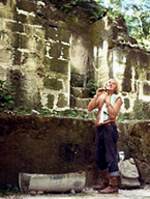
Esta introducción era necessaria porque sin este preludio no hubiera puesto mis pies en este lugar aislado. Pues bien, en seguida eché una ojeada a los pequeños locales insertos en el muro de este palacio. Allí descubrí los sgraffitos. Algunas me sembraron muy emocionantes. Era facil revelarles porque antes de mi visita talvez un arqueólogo les había marcado con su pencil para copiarlos. Sacqué unas fotos y hice copias del resto en mi diario. Quiero presentar aquí los dibujos encontrados. Esos son de differente cualidad y probablemente de eras diversas. Escluyo que son bromas gastadas por arqueólogos durante los años de restauro de todo Tikal. De otro lado solo arqueólogos conocen tantos detalles retratados. Naturalmente también los originales vividos, quizzás, 1200 años atrás los conocían. En esa época del 1976 los arqueólogos provenientes de los E.E.U.U. (Pennsylvania) ya se habían dirigidos hacia nuevos descubrimientos. Ahora un grupo de arqueólogos guatemaltecos estaban limpiando el Grupo G gracias a una beca del Gobierno. (Según Dr. William R.Coe) 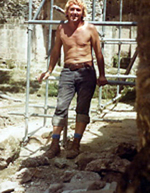
Esattamente 10 años más tarde, en el año 1986, visité de nuevo el mismo Grupo G y esta vez sin buscar una taza de agua para afeitarme, sino buscando los sgraffitos. ¡Que amarga sorpresa! Desparecidos todos. Durante mi primera visita los pequeños cuartos, los cuales antes de su restauro estaban cubiertos de tierra, roca y de la densa foresta, fueron cubiertos de chapas onduladas como protección contro la lluvia y de frondas de palmas por razón de estética. En el año 1986 nada más de protección contro los agentes atmosféricos de arriba. Los sgraffitos habían desaparecidos totalmente bajo la lluvia. Ahora una densa capa verdosa de moho cubrió todos los muros. Una razón más para presentar aquí mis hallazgos de una vez. Comprendo que para los señores turistas y los agentes de viaje de hoy la attracción no consiste en meditar de frente a estos sgraffitos. Nuevos pirámides despejados como la del Mundo Perdido attraen ya por su atractivo nombre del vocabulario turístico los visitantes, los cuales son siempre en busca de efectos sobresalientes. Mi pequeño e insignificante "Mundo perdido" habla en su lugar de individuos cuya existencia se testimoniaba hasta hoy o hace unas décadas. No eran piedras frías calladas como todo el resto del Tikal perceptible, sino huellas de la mano de seres humanos. A mi parecían como señales de vida de pobres ánimas humanas que rasgunaron un último salud al mundo antes de ser sacrificadas. Por eso los aprecio como rara curiosidad. |
|||||||||||||||
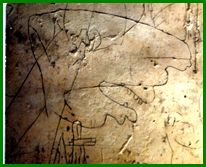 |
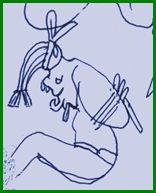 |
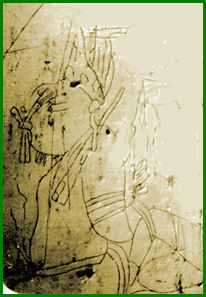 |
||||||||||||||||
Pain? Grief? Cruelty? ¿Rostro apenado? ¿Rostro cruel? |
Prisoner in loin-cloth and tied hairdo Cautivo con mechón atado esperando su ejecución |
Extreme long Ear-plug tied hairdo, arms and legs Mechón atado señala prisonero |
||||||||||||||||
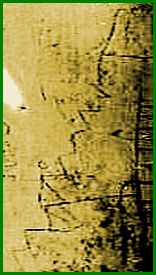 |
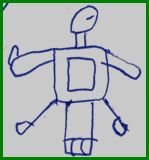 |
|||||||||||||||||
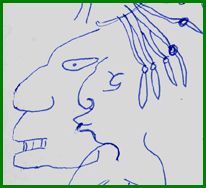 |
||||||||||||||||||
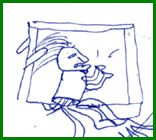 |
||||||||||||||||||
|
Tipical Maya head profile Tipica cabeza Maya deformada |
Terraced Temple with Stairs (on the right) Pirámide escalonada con graduada al lado derecho |
Top: Tortoise, simbol for long life Down: Open for interpretation |
||||||||||||||||
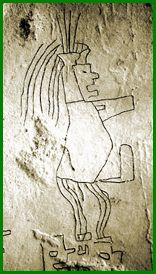 |
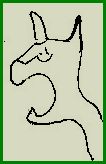 |
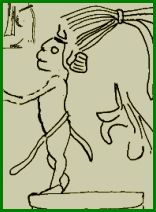 |
||||||||||||||||
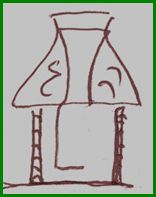 |
||||||||||||||||||
|
Quiet infantile and not a Maya head. Mexican? No cabeza Maya. ¿De época tardía? |
Top: Head of Jaguar Down: Pole-and-thatch building? |
A work of Student of Arts? Standing and playing leg! ¿Coincidencia? Pierna de apoyo y pierna desapoyada |
||||||||||||||||
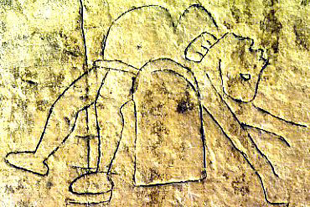 |
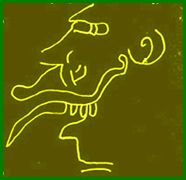 |
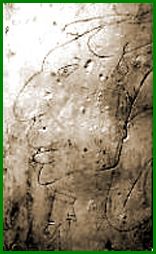 |
||||||||||||||||
|
Victim bending backwards facilitates chest opening for heart sacrifice Altar del Sacrificio con víctima y tórax abierto |
Masked Head Enmascherado (Trueque de blanco-negro) |
Typical Mayan features Hombre Maya de perfil con cabeza deformada |
||||||||||||||||
|
More of this five-month-long travel to Mexico and Guatemala is presented at the pdf-file "Farbenfrohes Guatemala", Internal link from here directly or starting at the pdf-Theke at your left. 5,37 MB, 57 pages, written in German, including numerous photographs of beautiful Guatemala and its indigenous population. Look also for the Galery of 48 clickable photos in thumbnail version at the end of "Wanderjahre" or here is the short-cut: Colorful Guatemala. Un relato en lengua alemana sobre esta excursion y con muchas fotos se pueden trovar en la PDF-Theke. Vea el titulo "Farbenfrohes Guatemala, 5.37MB, 57 paginas DIN A4. Es un filón también para quien ama los trajes indígenos de los pueblos más lejanos del país. Vea tambien la Galería de 48 fotos presentando Trajes de Guatemala. Escoja "Wanderjahre" o vaya aquí directamente: Colores de Guatemala |
||||||||||||||||||
